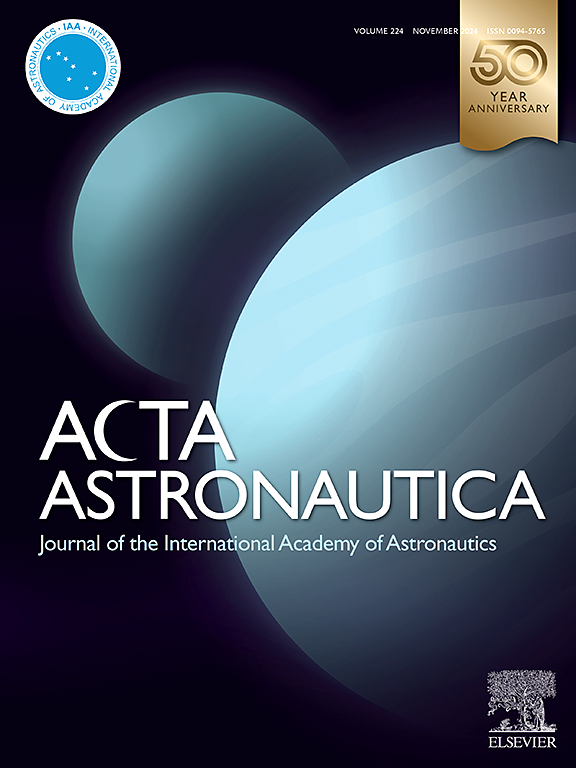从门户部署月球导航星座的制导策略
IF 3.1
2区 物理与天体物理
Q1 ENGINEERING, AEROSPACE
引用次数: 0
摘要
近年来,月球星座的设计和部署引起了科学界和主要太空机构的浓厚兴趣。事实上,类似的空间基础设施将成为导航和电信目的的宝贵资产,对月球表面的许多机器人和人类活动都很有用。本研究重点分析、设计和测试三种不同的反馈制导策略,用于月球星座的部署,从网关开始。轨道动力学在采用行星星历的高保真框架中建模,并包括所有相关的轨道扰动,即由于地球和太阳的引力以及硒势的几个谐波。考虑一个由6颗卫星组成的星座。它们在两个截然不同的冰冻月球椭圆轨道上运行,具有适当的相互相位。第一种部署策略假设每颗卫星都使用高推力推进进入其运行轨道,并具有正确的相位。为此,提出了一种基于单参数迭代的兰伯特算法,作为一种有效的实时制导技术,能够确定所有(适度)中间修正机动,以驱动每个卫星朝向期望的位置。第二种部署策略再次假定使用高推力,同时包括两个不同的阶段:(a)轨道获取和(b)分阶段。具体来说,在阶段(a)中,利用原始的双参数迭代兰伯特制导,三颗卫星被安排成一个集群并向其轨道行进。在阶段(b)中,每个飞行器执行相位机动,以获得正确的位置。第三个部署战略同样包括两个阶段:(a)低推力轨道获取和(b)分阶段。在阶段(a)中,卫星被集中并搭载在两艘货运飞船上,配备低推力推进系统。非线性轨道控制可以识别出低推力大小和低推力方向的饱和反馈律,并被证明是一种有效的针对每个货运飞行器的制导技术。利用李雅普诺夫稳定性理论,证明了闭环动力系统具有准全局稳定性。在阶段(b)中,每颗卫星再次执行阶段机动,就像前面的策略一样。在标称和非标称飞行条件下对这三种部署策略进行了评估,目的是在比较推进剂消耗和总体部署持续时间方面的性能的同时显示它们的有效性。本文章由计算机程序翻译,如有差异,请以英文原文为准。
Guidance strategies to deploy a Lunar Navigation Constellation from Gateway
In recent years, lunar constellation design and deployment has attracted a strong interest from the scientific community and the major space agencies. Indeed, a similar space infrastructure will represent a valuable asset for navigation and telecommunications purposes, useful to many robotic and human activities on the lunar surface. This study focuses on the analysis, design, and testing of three different feedback guidance strategies for the deployment of a lunar constellation, starting from Gateway. Orbit dynamics is modeled in a high-fidelity framework that employs planetary ephemeris and includes all the relevant orbit perturbations, i.e. the gravitational attraction due to Earth and Sun and several harmonics of the selenopotential. A constellation composed of 6 satellites is considered. They travel two distinct frozen lunar elliptical orbits, with proper mutual phasing. The first deployment strategy assumes that each satellite uses high-thrust propulsion to enter its operational orbit, with correct phasing. To do this, a single-parameter iterative Lambert-based algorithm is proposed as an effective real-time guidance technique, capable of determining all the (modest) intermediate correction maneuvers, to drive each satellite toward the desired position. The second deployment strategy assumes again the use of high thrust, while including two distinct phases: (a) orbit acquisition and (b) phasing. Specifically, in phase (a) three satellites are arranged as a cluster and travel toward their orbit, leveraging an original two-parameter iterative Lambert-based guidance. In phase (b), each vehicle performs phasing maneuvers, to get its correct position. The third deployment strategy includes again two phases: (a) low-thrust orbit acquisition and (b) phasing. In phase (a), the satellites are clustered and embarked onboard two cargo spacecraft, equipped with a low-thrust propulsion system. Nonlinear orbit control allows identifying a saturated feedback law for the low thrust magnitude and direction, and is shown to be effective as a guidance technique for each cargo vehicle. The closed-loop dynamical system at hand is proven to enjoy quasi-global stability properties, leveraging the Lyapunov stability theory. In phase (b), each satellite performs again phasing maneuvers, as in the preceding strategy. The three deployment strategies are evaluated in both nominal and nonnominal flight conditions, with the intent of showing their effectiveness while comparing their performance, in terms of propellant consumption and overall deployment duration.
求助全文
通过发布文献求助,成功后即可免费获取论文全文。
去求助
来源期刊

Acta Astronautica
工程技术-工程:宇航
CiteScore
7.20
自引率
22.90%
发文量
599
审稿时长
53 days
期刊介绍:
Acta Astronautica is sponsored by the International Academy of Astronautics. Content is based on original contributions in all fields of basic, engineering, life and social space sciences and of space technology related to:
The peaceful scientific exploration of space,
Its exploitation for human welfare and progress,
Conception, design, development and operation of space-borne and Earth-based systems,
In addition to regular issues, the journal publishes selected proceedings of the annual International Astronautical Congress (IAC), transactions of the IAA and special issues on topics of current interest, such as microgravity, space station technology, geostationary orbits, and space economics. Other subject areas include satellite technology, space transportation and communications, space energy, power and propulsion, astrodynamics, extraterrestrial intelligence and Earth observations.
 求助内容:
求助内容: 应助结果提醒方式:
应助结果提醒方式:


